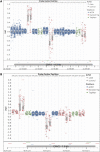Analysis of Copy Number Variants on Chromosome 21 in Down Syndrome-Associated Congenital Heart Defects
- PMID: 29141989
- PMCID: PMC5765339
- DOI: 10.1534/g3.117.300366
Analysis of Copy Number Variants on Chromosome 21 in Down Syndrome-Associated Congenital Heart Defects
Abstract
One in five people with Down syndrome (DS) are born with an atrioventricular septal defect (AVSD), an incidence 2000 times higher than in the euploid population. The genetic loci that contribute to this risk are poorly understood. In this study, we tested two hypotheses: (1) individuals with DS carrying chromosome 21 copy number variants (CNVs) that interrupt exons may be protected from AVSD, because these CNVs return AVSD susceptibility loci back to disomy, and (2) individuals with DS carrying chromosome 21 genes spanned by microduplications are at greater risk for AVSD because these microduplications boost the dosage of AVSD susceptibility loci beyond a tolerable threshold. We tested 198 case individuals with DS+AVSD, and 211 control individuals with DS and a normal heart, using a custom microarray with dense probes tiled on chromosome 21 for array CGH (aCGH). We found that neither an individual chromosome 21 CNV nor any individual gene intersected by a CNV was associated with AVSD in DS. Burden analyses revealed that African American controls had more bases covered by rare deletions than did African American cases. Inversely, we found that Caucasian cases had more genes intersected by rare duplications than did Caucasian controls. We also showed that previously DS+AVSD (DS and a complete AVSD)-associated common CNVs on chromosome 21 failed to replicate. This research adds to the swell of evidence indicating that DS-associated AVSD is similarly heterogeneous, as is AVSD in the euploid population.
Keywords: Down syndrome; congenital heart defects; copy number variation.
Copyright © 2018 Rambo-Martin et al.
Figures

References
-
- Freeman S. B., Taft L. F., Dooley K. J., Allran K., Sherman S. L., et al. , 1998. Population-based study of congenital heart defects in Down syndrome. Am. J. Med. Genet. 80: 213–217. - PubMed
-
- Freeman S. B., Bean L. H., Allen E. G., Tinker S. W., Locke A. E., et al. , 2008. Ethnicity, sex, and the incidence of congenital heart defects: a report from the National Down Syndrome Project. Genet Med. 10: 173–180. - PubMed
MeSH terms
Supplementary concepts
Grants and funding
LinkOut - more resources
Full Text Sources
Other Literature Sources
Medical
Molecular Biology Databases
